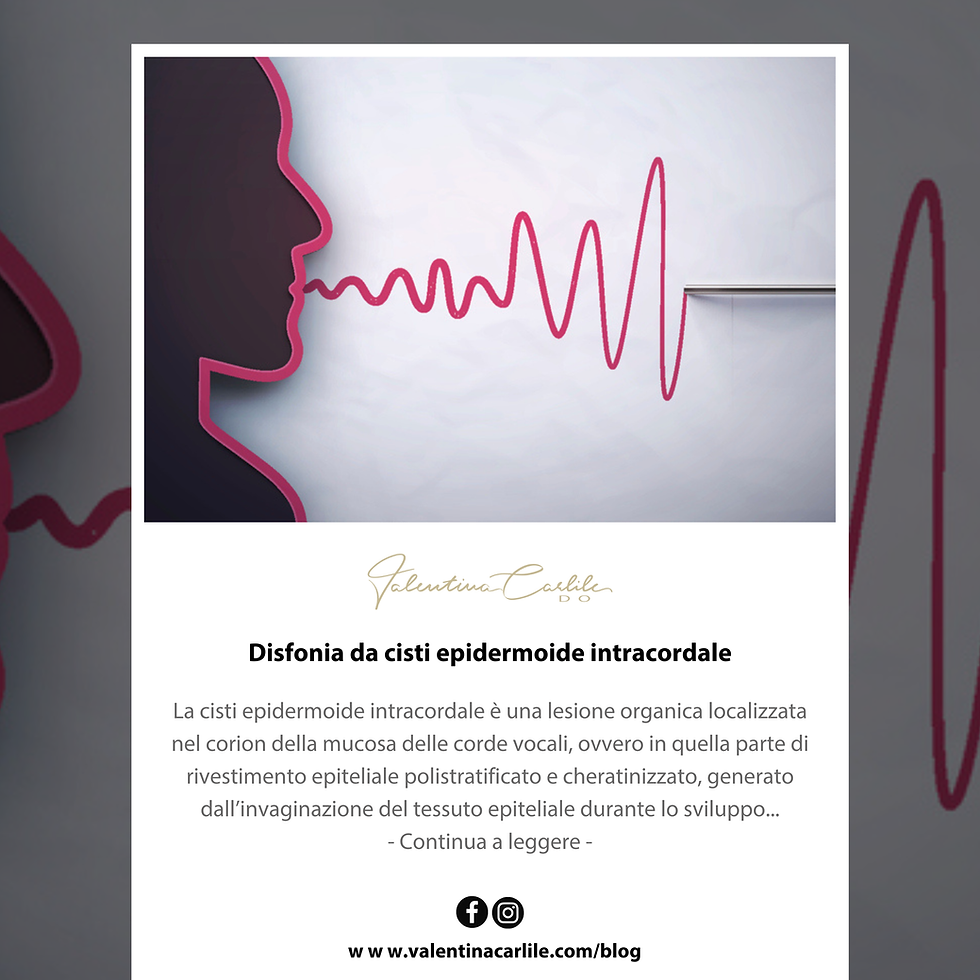What is the voice? Definition, anatomy and parameters that make it irreproducible
- Valentina Carlile DO

- Dec 14, 2015
- 3 min read

The voice can be defined as an acoustic signal characterized by a fundamental frequency and a series of harmonics modified by the resonance cavities. However, the voice is also the result of the passage through the resonance cavities of the complex acoustic signal produced at the glottic level by the subsequent compressions and rarefactions suffered by the exhaled air.
From an anatomophysiological point of view, the voice is the product of a biomechanical system that includes different systems and organs: the central nervous system (CNS), the resonance system, the larynx, the respiratory system. However, the protagonist of phonation is the larynx, an unpaired median organ located in the anterior region of the neck.
The larynx is a suspended organ formed by a cartilaginous skeleton which includes the cricoid cartilage with the superimposed arytenoid cartilages and the thyroid cartilage. These cartilages are articulated together in such a way as to make possible the movements that the larynx performs both globally and in the different segments. These movements are ensured by a rich intrinsic muscular system and a smaller extrinsic muscular system. Laryngeal innervation is provided by two branches of the CN superior laryngeus, which supplies sensory fibers and some motor fibers for the thyroarytenoid muscle, and the inferior laryngeus (recurrent) which provides the entire motor innervation of the larynx.
Inside the larynx there are 4 vocal cords separated by the cavity called the ventricle of Morgagni. These 4 vocal cores are distributed on two floors. Those on the lower level are called true (CVV) while those on the upper level are called false vocal cords (CVF). CVVs are responsible for speech production while CVFs are only involved in functions such as coughing and swallowing.
During an inhalation, lung dilation gives rise to low intrathoracic pressure which 'sucks in' air from the outside (Bernoulli effect). Immediately after intrapulmonary gas exchanges have taken place, the contraction of the expiratory muscles produces an increase in intrathoracic pressure, thus releasing deoxygenated air (CO2). This CO2 passes through the respiratory system arriving in the larynx, where the encounter with the adducted vocal cords causes the gas particles to vibrate, generating sound. From a physical-chemical point of view, therefore, the voice is nothing other than the sonorization of gaseous particles. This voiced air current then passes through the structures above the larynx, i.e. the resonance cavities (pharynx, oral cavity, nasal cavities), which will modify the physical characteristics of the sound by amplifying or dampening the harmonics of the sound wave.
Resonators are structures with limited but proper mobility and their volume can be modified by structures such as the tongue (mostly articulated) and pendulous veil. It is precisely the resonators that determine the vocal timbre of each individual, making it unique and this is the reason why it is impossible to find two people with the same voice.
The voice can be divided into three parameters: pitch, volume and timbre.
The pitch is given by the frequency of the sound, i.e. the number of opening-closing cycles of the CVVs per second. Depending on the frequency, a voice can be high-pitched (high frequencies) or low-pitched (low frequencies). The frequency varies with age (children have higher voices than adults) and sex (men have lower voices than women). Each individual is able to produce different frequencies (vocal range) while having a preferential one (fundamental frequency F0).
The volume depends on the amplitude of the vibration of the edge of the vocal folds which is in turn determined by the subglottic pressure (the higher the pressure, the louder the volume of the voice. Depending on the volume the voice can be loud or weak.
The timbre, already analyzed from an anatomical point of view, from a physical point of view is given by the shape of the sound wave which is the result of the basic tone and the harmonics. The sound produced at the larynx passes through the resonators which modify it by amplifying or dampening the different frequency ranges.





Comments